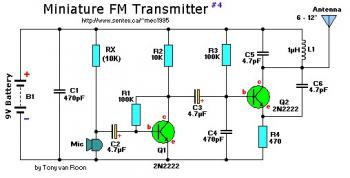The following diagram is the circuit diagram of 9V Mini FM Transmitter.
Schematic diagram:
Components List:
R1,R3 = 100K
R2 = 10K
R4 = 470 ohm
C1,C4 = 470pF
C2,C3 = 4.7µF/16V
C5,C6 = 4.7pF
C7 = 4-40pF trimmer cap (optional, see text)
L1 = 1µH
Q1,Q2 = 2N2222, NPN transistor
Mic = Electret Microphone
B1 = 9 Volt battery
Circuit Notes:
Absolutely nothing crucial here. To get a bit of tuning out of the coil you could put a 4-40pF trimmer capacitor (optional) parallel over the 1 µH coil, L1.
C1/C4 and C5/C6 are ceramic capacitors, preferably NPO (low noise) types. C2/C3 are electrolytic or can be tantalum kinds.
In the event you determine to substitute transistors with some thing similar you already have, it perhaps necessary adjust the collector voltage of Q1 by changing the value of R2 or R3 (simply because you alter transistors, it changes this bias on the base of Q1). It ought to be about 1/2 the supply voltage (about four or 5v).
The antenna is nothing more than a piece of 12" wire or a piece of piano wire from 6" to 12".
To find the signal on your regular FM Radio dial, make certain there's a signal coming into the microphone, otherwise the circuit will not function. I use an old mechanical alarm clock (you know, with those two big bells on it). I put this clock by the microphone which picks up the loud tick-tock. I'm certain you get the concept... Or you can just lightly tap the microphone whilst looking for the location of the signal on your receiver.
The antenna is nothing more than a piece of 12" wire or a piece of piano wire from 6" to 12".
To find the signal on your standard FM Radio dial, make sure there is a signal coming into the microphone, otherwise the circuit won't work. I use an old mechanical alarm clock (you know, with those two large bells on it). I put this clock by the microphone which picks up the loud tick-tock. I'm sure you get the idea... Or you can just lightly tap the microphone while searching for the location of the signal on your receiver.
Source: http://www.sentex.ca/~mec1995/circ/fmt4.html
Design by Tony van Roon
